Pokhara
Pokhara is a remarkable place of natural beauty. Situated at an altitude of 827m from the sea level and 200 km west of Kathmandu Valley, the city is known as a center of adventure. The enchanting city has several beautiful lakes and offers s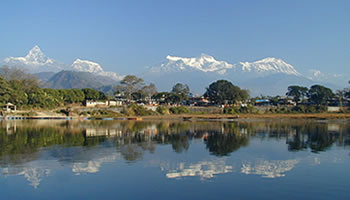 tunning panoramic views of the Himalayan peaks. The serenity of lakes and the magnificence of the Himalayas rising behind them create an ambience of peace and magic. So today the city has not only become the starting point for most popular trekking and rafting destinations but also a place to relax and enjoy the beauty of nature. tunning panoramic views of the Himalayan peaks. The serenity of lakes and the magnificence of the Himalayas rising behind them create an ambience of peace and magic. So today the city has not only become the starting point for most popular trekking and rafting destinations but also a place to relax and enjoy the beauty of nature.
Pokhara is part of a once vibrant trade route extending between India and Tibet. To this day, mule trains can be seen camped on the outskirts of the town, bringing goods to trade from remote regions of the Himalaya. This is the land of Magars and Gurungs, hardworking farmers and valorous warriors who have earned worldwide fame as Gurkha soldiers. The Thakalis, another important ethnic group here, are known for their entrepreneurship.
The climate of Pokhara is slightly warmer than Kathmandu with daytime temperature hovering around 150 C in winter and 350 C in summer. The monsoon season, which last from mid-June to mid-September, is very wet. In fact, Pokhara records the highest rainfall in the country. Best time to visit is between October and April.
The activities of foreign visitors to Pokhara focus around two districts known as Damside and Lakeside (in Nepali Pardi and Baidam respectively). These two areas, with their strips of hotels and restaurants, are a few kilometers south-west of the main Pokhara bazaar.
Places of Interest:
Phewa Lake
Phewa Lake, the second largest lake in the kingdom, roughly measuring 1.5 km by 4 km, is the center of all attractions in Pokhara. The enchanting lake is a peaceful playground. Brightly painted wooden boats and sailboats can be rented at reasonable price around lakeside.
The lake is neither deep (roughly 47m at most) nor p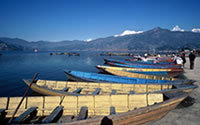 articularly clean, but the water is warm and swimming is pleasant if you don't think about the probable pollution. The eastern shoreline of the lake, popularly known as Lakeside or Baidam, consists of seemingly endless strip of lodges, restaurants, bookshops and souvenir shops. One of the fascinating parts of Lakeside is the splendid view of the mountains, especially when the still water reflects the peaks, creating a double image. articularly clean, but the water is warm and swimming is pleasant if you don't think about the probable pollution. The eastern shoreline of the lake, popularly known as Lakeside or Baidam, consists of seemingly endless strip of lodges, restaurants, bookshops and souvenir shops. One of the fascinating parts of Lakeside is the splendid view of the mountains, especially when the still water reflects the peaks, creating a double image.
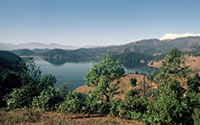 Begnas Lake and Rupa Lake Begnas Lake and Rupa Lake
The lakes are located about 15 km from Pokhara at the end of a road that turns north from the highway to Kathmandu. Divided by the forested hillock, the lakes offer the perfect nature retreat because of their relative seclusion. Splendid boating and fishing can be done here.
Barahi Temple
This is the most important religious monument in Pokhara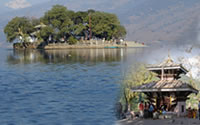 . Built almost in the middle of Phewa Lake, the two-storied pagoda is dedicated to the boar manifestation of Ajima, the protectress deity representing the female force Shakti. Devotees can be seen, especially on Saturdays, carrying male animals and fowl across the lake to be sacrificed to the deity. . Built almost in the middle of Phewa Lake, the two-storied pagoda is dedicated to the boar manifestation of Ajima, the protectress deity representing the female force Shakti. Devotees can be seen, especially on Saturdays, carrying male animals and fowl across the lake to be sacrificed to the deity.
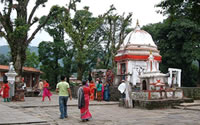 Bindyabashini Temple Bindyabashini Temple
Bindyabashini Temple is the center of religious activity in the old bazaar. It is dedicated to goddess Bhagwati, yet another manifestation of Shakti. Worshippers flock here to perform sacrifices, and especially on Saturdays the park like grounds take on a festive fair.
World Peace Pagoda
The Pagoda is a massive Buddhist Stupa a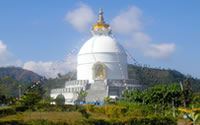 nd is situated on the top of a hill on the southern shore of Phewa Lake. Besides being an impressive sight in itself, the shrine is a great vantage point, which offers spectacular views of the Annapurna range and Pokhara city. One can get there by crossing the lake by boat and then hiking up the hill. nd is situated on the top of a hill on the southern shore of Phewa Lake. Besides being an impressive sight in itself, the shrine is a great vantage point, which offers spectacular views of the Annapurna range and Pokhara city. One can get there by crossing the lake by boat and then hiking up the hill.
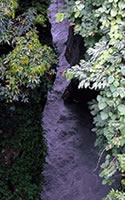
Seti Gandaki Gorge
Flowing right through the city, the boisterous river runs completely underground at places. Amazingly, at certain points the river appears hardly two meters wide. But its depth is quite beyond imagination – over 20 meters! Mahendra Pul, a small bridge near the old Mission Hospital, provides a perfect view of the river's dreadful rush and the deep gorge made by its powerful flow.
Davi's Fall
Locall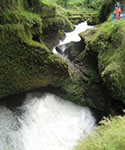 y known as Patale Chhango (Hell's Fall), Davi's Fall, also known as Davy's or David's Fall, is an awesome waterfall lying about 2 km south-west of Pokhara Airport on the highway to Tansen. The waterfall directly goes into a deep and narrow canal with no end. It is believed that this deadly waterfall took the life of a tourist named David, who fell down into the canal and was never found, and hence the name David Waterfall, named in his memory by the people of Pokhara. y known as Patale Chhango (Hell's Fall), Davi's Fall, also known as Davy's or David's Fall, is an awesome waterfall lying about 2 km south-west of Pokhara Airport on the highway to Tansen. The waterfall directly goes into a deep and narrow canal with no end. It is believed that this deadly waterfall took the life of a tourist named David, who fell down into the canal and was never found, and hence the name David Waterfall, named in his memory by the people of Pokhara.
Gupteshwor Cave
Guptesh wor Cave, a sacred cave, lies 2 km from Pokhara Airport on the Siddhartha Highway leading south-west from the city. The entrance is right across from Davi's Fall and the cave is almost 3 km long. It has some big hall-size rooms and some passages where one has to crawl on all fours. This cave holds special value for Hindus since a phallic symbol of Lord Shiva is preserved here in the condition it was discovered. wor Cave, a sacred cave, lies 2 km from Pokhara Airport on the Siddhartha Highway leading south-west from the city. The entrance is right across from Davi's Fall and the cave is almost 3 km long. It has some big hall-size rooms and some passages where one has to crawl on all fours. This cave holds special value for Hindus since a phallic symbol of Lord Shiva is preserved here in the condition it was discovered.
Mahendra Cave
Mahendra Cave, residing in the northern settlements of the Pokhara Valley, locally called C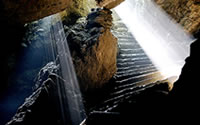 hamero Odhaar (House of Bats), is the large limestone cave. Shepherd boys are said to have discovered it around 1950. The cave has been fitted with lighting system for convenience of the tourists. It is known for its rock types and stones that glitter when a beam of light hits them. So, it is best to bring your own torch light to see the stalactites and stalagmites, although most of them have been carted out by souvenir hunters. hamero Odhaar (House of Bats), is the large limestone cave. Shepherd boys are said to have discovered it around 1950. The cave has been fitted with lighting system for convenience of the tourists. It is known for its rock types and stones that glitter when a beam of light hits them. So, it is best to bring your own torch light to see the stalactites and stalagmites, although most of them have been carted out by souvenir hunters.
Museums
The Pokhara Museum, located between the bus stop and Mahendra Pul, reflects the ethnic mosaic of western Nepal. The lifestyles and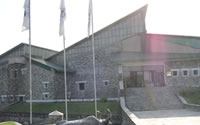 history of ethnic groups such as Gurungs, Thakalis and Tharus are attractively displayed through models, photographs and artifacts. One major attraction is a display highlighting the newly-discovered remains of an 8000-year-old settlement in Mustang. It is open daily, except Tuesdays and holidays, from 10:00 am to 5:00 pm. history of ethnic groups such as Gurungs, Thakalis and Tharus are attractively displayed through models, photographs and artifacts. One major attraction is a display highlighting the newly-discovered remains of an 8000-year-old settlement in Mustang. It is open daily, except Tuesdays and holidays, from 10:00 am to 5:00 pm.
The Annapurna Regional Museum, also known as the Natural History Museum, is another interesting visit in Pokhara. Run by the Annapurna Conservation Area Project (ACAP), the museum has an exceptional collection of butterflies, insects, birds and models of wildlife found in the area. Located at Prithvi Narayan Campus east of the old bazaar, it is open daily except Saturdays and holidays from 9:00 am to 5:00 pm.
Surrounding Areas
Pokhara is the starting and/or finishing point for some of the most popular treks. It also offers 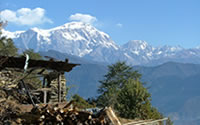 a number of short treks for those who cannot opt for long, challenging ones. The most popular destination among them is Sarangkot (1592 m), a former Kaski fort lying atop a hill to the west of Pokhara. The panoramic view of the Himalaya seen from this point is superb. Kahundanda, Naudanda, Ghandrung, Ghorepani, and Ghalchok are other favorite destinations around Pokhara. a number of short treks for those who cannot opt for long, challenging ones. The most popular destination among them is Sarangkot (1592 m), a former Kaski fort lying atop a hill to the west of Pokhara. The panoramic view of the Himalaya seen from this point is superb. Kahundanda, Naudanda, Ghandrung, Ghorepani, and Ghalchok are other favorite destinations around Pokhara.
Gorkha
Situated at 140 km west of Kathman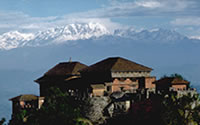 du, at an altitude of 1135m, Gorkha offers panoramic views of snow-fed mountains. It is the birthplace of King Prithvi Narayan Shah the Great, founder of modern Nepal and ancestral hometown of the Shah dynasty of Nepal. It is situated on a hilltop, just around 18 km up a paved road of the Pokhara-Kathmandu Highway. Gorkha's small town is perhaps the most important historical town of Nepal. du, at an altitude of 1135m, Gorkha offers panoramic views of snow-fed mountains. It is the birthplace of King Prithvi Narayan Shah the Great, founder of modern Nepal and ancestral hometown of the Shah dynasty of Nepal. It is situated on a hilltop, just around 18 km up a paved road of the Pokhara-Kathmandu Highway. Gorkha's small town is perhaps the most important historical town of Nepal.
With a clear view of the Himalayas, lies the beautiful old Gorkha Palace known as Gorkha Durbar - outstanding for its Nepalese architecture from where King Prithvi Narayan Shah began his campaign to unify the kingdom, a wildly ambitious project which succeeded due to his brilliance, and the effectiveness of his locally recruited troops. The British term ‘Gurkha’ evolved from the name Gorkha, referring to the famed fighting soldiers of the region. There are two attractive temples of Gorakhnath and Gorakhkali inside the palace premises.
Gorkha is also a national pilgrimage spot. Its centerpiece is the seventeenth-century Gorkha Durbar, which is a fort, a palace and a temple with excellent views of the Manaslu range. If you seek to trek from Gorkha, there is no where a better place to taste some of Nepal's hillside experience than from Gorkha.
Places to visit:
Gorkha Durbar
It is the main attraction of Gorkha, an hour steep walk up a hill from the bazaar area. It is used to be the dwelling of King Prithvi Narayan Shah and his ancestors. The Durbar itself is a humble, yet quite impressive complex of a temple, fort, and a palace built in the Newari style of Kathmandu. The view of the Himalayan range and the deep valleys from up there is quite wonderful.
Gorakhnath Cave
Ten meters below the palace's southern side, is the sacred temple of Gorakhnath. The cave is carved out of the solid rock and is among the most important religious sites for mainstream Brahmins and Chhetris of Nepal.
Gorkha Bazaar
It is primarily a cobbled street market place whereby people from neighboring hill dwelling come to trade. There are a few temples nearby like Kalika Mandir (Temple) up the hill from the main bazaar. Yet, it is worth a visit as it provides a very good vista of the quiet charm that soaks a typical hill village of Nepal.
Upallokot
It is situated at a 20 minute walking distance from Gorkha Palace. There is a viewing platform at an altitude of 1520m in Upallokot from where the fantastic view of Gorkha Palace and the silver shining snow-fed peaks can be enjoyed.
 Manakamana Temple Manakamana Temple
On a beautiful ridge southeast of the township of Gorkha lies the holy temple of Manakamana, the holly goddess of aspirations. It is a famous pilgrimage site for Hindus. It can be reached by hiking from Abu Khaireni (3 hrs) or by cable car from Cheres on the main highway.
Bandipur
Located on a 1000m ridge in Tanahu district some 140 km from Kathmandu, Bandipur's hallmark is its beautiful scenery. Its medium elevation, excellent view of the Himalayas (Dhaulagiri, Annapurna, Manaslu, Ganesh, Langtang), the Marshyangdi Valley, Manakamana Hill and Gorkha with its high perching palace, relatively easy accessibility and, of course, old Newari town flair, make Bandipur an interesting tourist destination.
The various Newari and Magar festivals, which until recently have been held for own purposes several times a year, can also be of interest to tourists. Sorathi and Chutka dances are very popular.
Other attractions include the pagoda-roofed Bindyabashini Temple which houses goddess Durga (Bandipur's Guardian Deity), the library in the village centre, Thani Mai, Tindhara (‘Three Taps’ washing place at the southeastern outskirts), Raniban (Queen's Forest), a downhill trek to the Siddha Cave and a hike to Ramkot village. On Mukundeswori, the elevation at the western end of the saddle, is a little shrine and one has a view of Bandipur itself. The other important temples and shrines in the vicinity include the Mahalaxmi Temple with its exquisite wood-work and the Khadga Devi Temple which comes alive once a year during the Dashain festival.
Lumbini
This is the birth place of Siddhartha Gautam, the Shakya Prince and the ultimate Buddha, the enlightened one. It is the pilgrimage destination of the people faithful to all schools of Buddhism. This nat ivity site, identified by Indian Emperor Ashoka's commemorative pillar, is listed as a World Heritage Site by UNESCO. ivity site, identified by Indian Emperor Ashoka's commemorative pillar, is listed as a World Heritage Site by UNESCO.
About 30 km east of Lumbini is the village of Tilaurakot which is believed to have been the location of the Kapilvastu Royal Palace where the Buddha grew up as the Shakya dynasty prince, until he renounced it at the age of 29 in search of enlightenment. Kapilvastu is associated with several incidents of his life such as: meeting the sick person, meditation of Saint Asit, competition with Shakya youth, shooting of an arrow to cause the spring of water to gush out and so on. When Buddha got enlightenment in Bodhgaya, 500 Shakyas and 8 princes adopted Buddhism at this place. At this place he preached his father and son Rahul also.
The main attraction at Lumbini remains the sacred garden spread over 8 sq. km. and possessing all the treasures of the historic area. The Mayadevi Temple is the main attraction for pilgrims and archaeologists alike. Here we find a bath relief of Mayadevi, the Buddha's mother giving birth to him. Standing west to the Mayadevi shrine is the oldest monument of Nepal, the Ahsokan pillar. The pillar was erected by Emperor Ashoka in 249 BC to commemorate his pilgrimage to the sacred site. To the south of the pillar, we find the sacred pond, Puskarni, where Queen Mayadevi had taken a bath just before giving birth to Lord Buddha. Nearby there are other places of interest too.
Very recently, several Buddhist countries have built several beautiful shrines in Lumbini. An international committee has also been set up for the development of this sacred historical place. The visit to Lumbini, the birthplace of Buddha, the realm of the Shakya is not only for spiritual enlightenment but also for solace and satisfaction that one normally gets in a calm and peaceful place like this.
Places to visit:
Sacred G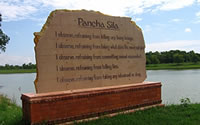 arden arden
Which is spread over 8 sq. km. possesses all the treasures of the historic area. It has been listed by UNESCO as a World Heritage Site. This is the place where Lord Buddha was born. The site is marked by Ashokan Stone Pillar, which has an engraved inscription identifying the spot as the birthplace of Lord Buddha. On one side of the pillar is the Mayadevi Temple, the temple of the mother of Lord Buddha. Recent excavations have turned up a stone bearing footprints of Lord Buddha.
 The Ashokan Pillar The Ashokan Pillar
Discovered by the now famous German archaeologist Dr. Fuhrer, the pillar is the first epigraphic evidence relating to the life history of Lord Buddha. The historic importance of the pillar is evidenced by the inscription engraved in the pillar (in Brahmi script). It is said that the great Indian Emperor Ashoka visited the site in the 20th year of his ascendancy to the throne and as homage to the birthplace, erected the pillar. The pillar is situated nearby the Sacred Garden.
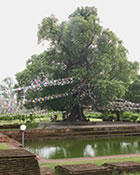 Puskarni Pond Puskarni Pond
Located south of the Ashokan Pillar is the pond where Queen Mayadevi, the mother of Lord Buddha, is believed to have taken a bath before giving birth to Lord Buddha. Architecturally the pond has the projecting terraces in descending order and is reverted with fine brick masonry.
Lumbini Museum
Located in the Cultural Zone, it contains Mauryan and Kushana coins, religious manuscripts, terra-cotta fragments, stone and metal sculptures, it also possesses an extensive collection of stamps from various countries depicting Lumbini and the Buddha.
Lumbini International Research Institute (LIRI)
Located opposite to the Lumbini Museum, LIRI provides research facilities for the study of Buddhism and re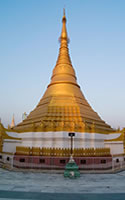 ligion in general. Run jointly by the Lumbini Development Trust (LDT) and the Reiyukai of Japan, LIRI contains numerous books on religion, philosophy, art and architecture. ligion in general. Run jointly by the Lumbini Development Trust (LDT) and the Reiyukai of Japan, LIRI contains numerous books on religion, philosophy, art and architecture.
Kapilvastu Museum
Kapilvastu Museum is situated 27 km west of Lumbini in the village of Tilaurakot. The museum holds coins, pottery and toys dating between the 7th century BC and 4th century AD. The museum also has a good collection of jewelry and other ornaments of that period.
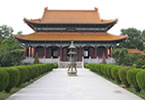 China Temple China Temple
The magnificent China Temple is a complex of pagodas, prayer rooms and meditation cells. Built by the Buddhist Association of China, the centerpiece at the Zhong Hua Buddhist Monastery is a huge statue of the Buddha housed in its main pagoda. The exquisitely worked sloping roofs, vivid colors and pleasant walkways add to its beauty.
Korean Temple
It is a fine architectural representation of Korea, which contains beautiful images of Lord Buddha.
Tansen
The township of Tansen is among a few towns outside Kathmandu, which bears a rich legacy of the traditional art and architecture. Perched on the lap of the spectacular Shreenagar Danda (Hill), Tansen comm ands a gorgeous panorama of the Himalayas as well as the plains of Terai. On account of its unique geographical location, climate and the people, it spells an aura of dreamy holiday. Located at an elevation of 1310m, it is a pleasant place to visit during any season of the year. ands a gorgeous panorama of the Himalayas as well as the plains of Terai. On account of its unique geographical location, climate and the people, it spells an aura of dreamy holiday. Located at an elevation of 1310m, it is a pleasant place to visit during any season of the year.
The hill of Shreenagar, half an hour walk up Tansen Bazaar at an elevation of 1524m, is a vantage point to view the contrasting manifestation of nature. An incredibly long panorama of the mountains surrounding Kanjirowa, Dhaulagiri, Annapurna and Langtang at a stretch is visible from here on one hand, while on the other the plains of Mardi valley and the bigger Terai also comes to distinct view from the same point. Tansen also provides opportunity for study of Buddhist culture and the life and culture of Magar tribes.
Places to visit:
Shreenagar Hill
One of the most picturesque spots in the whole Palpa region, Shreenagar Hill abounds in scenic grandeur and magnificent natural surroundings. A mere 30 minutes climb on foot or 10 minutes drive from the town of Tansen, one would reach the top of the hill which commands a unique spectrum of natural extravaganza - from the snowcapped Himalayan peaks in the north to the lush green wide expanse of plains of Terai in the south and of course, the panoramic view of the Tansen Town. The impressive meadow on the hilltop is an ideal spot to view the breathtaking scenes of majestic Dhaulagiri, Annapurna and the famous twin peaks of Machhapuchhre. Also, many beautiful short walks and excursions may be enjoyed from this point. To the comfort of the visitors, there are newly built facilities like cottages and camping sites on the top of the hill. An added attraction is a recently built 'Twa-dewa', a huge Newari style bronze lamp stand.
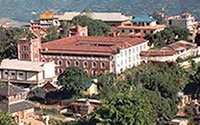 Tansen Durbar Tansen Durbar
Built in 1927 AD by Pratap Shamsher Jang Bahadur Rana, the Durbar is a grand imposing palace in the heart of the town. Once it was the seat of the Rana governors, the Durbar is now the district secretariat of Palpa district.
Amar Narayan Temple
Built in 1807 AD by Amar Singh Thapa, the temple of Am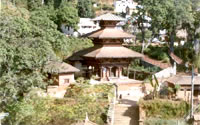 ar Narayan is considered an important landmark of Tansen. It is built in typical Nepali Pagoda style for its historical and architectural significance. The intricate works of woodcarvings in the temple are simply marvelous. The temple is surrounded by one-meter wide stonewall, locally known as the 'Great Wall of Palpa'. Inside the temple-complex, there are the temple of Lord Shiva, ponds, parks, rest houses and a natural water spring. Every morning and evening devotees gather at the compound and chant 'Bhajans' (holy recitals) in chorus. ar Narayan is considered an important landmark of Tansen. It is built in typical Nepali Pagoda style for its historical and architectural significance. The intricate works of woodcarvings in the temple are simply marvelous. The temple is surrounded by one-meter wide stonewall, locally known as the 'Great Wall of Palpa'. Inside the temple-complex, there are the temple of Lord Shiva, ponds, parks, rest houses and a natural water spring. Every morning and evening devotees gather at the compound and chant 'Bhajans' (holy recitals) in chorus.
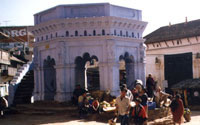 Shital Pati (Shady Rest House) Shital Pati (Shady Rest House)
Built by Khadga Shamsher, the original Shital Pati is of octagonal shape. A round house around the Shital Pati has been recently built. The historically important Shital Pati is a popular hang out for the locals now. The 'Baggi Dhoka', the biggest gate of its kind in Nepal is located in this square. The locals often compare it with the architecture of Mugal Empire in India.
Bhagawati Temple
B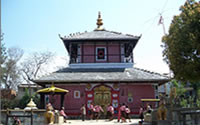 uilt by Ujir Singh Thapa in 1814 AD to mark the victory over colonial British-India forces, the temple is a small structure but holds immense religions importance. It is said that the original structure was remarkably bigger and more beautiful and it has undergone many physical adjustments, most recently after the great earthquake of 1934. Every year in the month of August, a chariot procession of deities is taken out throughout the town with military honor to observe the historic battle. uilt by Ujir Singh Thapa in 1814 AD to mark the victory over colonial British-India forces, the temple is a small structure but holds immense religions importance. It is said that the original structure was remarkably bigger and more beautiful and it has undergone many physical adjustments, most recently after the great earthquake of 1934. Every year in the month of August, a chariot procession of deities is taken out throughout the town with military honor to observe the historic battle.
Amar Jung Ganesh Temple
Before building the Amar Narayan Temple in 1807 AD, Amar Singh Thapa had built this temple. Architecturally, the temple bears the same style and character of Amar Narayan Temple. The temple has a big artistic 'Rest House' where a school is been run presently.
Taksar
It is another interesting place of the town, where, for centuries the famous bronze and brass works of Tansen are produced. One can have a look at how the famous ancient articles such as Karuwa (Water Jug), Hukka (Water Pipe), Antee (Jug for Nepali Brandy) etc. are produced.
Surrounding Areas:
Ghorbanda - Kumal Gaon (Potter's Village)
The village of Ghorbanda is on the way to Pokhara from Tansen. It is the best place to see the unique style of pottery making in Nepal. The articles produced here are traditional water pitchers, pots and Hands (a vessel with holes in the bottom; used for brewing Nepali Brandy).
Ranighat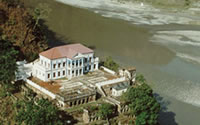
Ranighat is the palace built on the banks of the Kali Gandaki River by Khadka Shamsher in remembrance of his beloved wife Tej Kumari. It takes about 2 hrs to reach this place from Tansen. On the way, one has to pass through a small settlement called ‘Hatti Dhunga’ (Elephant Stone).
Ramdi
A half-day walk through fertile landscape shaped by te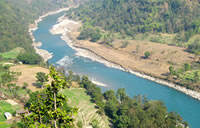 rraced rice fields lead to Ramdi at the banks of the Kali Gandaki River. Ramdi is a ‘Ghat’ (cremation place) where people bring their deceased relatives for their final rites. Besides this, Ramdi is famous for its cave temples, where the farmers from surrounding villages offer milk to protect their cattle from leopards and jackals. rraced rice fields lead to Ramdi at the banks of the Kali Gandaki River. Ramdi is a ‘Ghat’ (cremation place) where people bring their deceased relatives for their final rites. Besides this, Ramdi is famous for its cave temples, where the farmers from surrounding villages offer milk to protect their cattle from leopards and jackals.
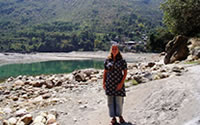 Ridi Ridi
Ridi, sacredly located at the confluence of the Ridi Khola (Stream) and the Kali Gandaki, is visited by pilgrims from Nepal and India who take holy bathes and worship at the temples. Additionally, like in Pashupatinath, in Kathmandu, old people arrive and stay here to take their last breath and get cremated at the banks of the holy Kali Gandaki. Furthermore, Ridi is the locality for the biggest yearly fair of the area. The walk down to Ridi will take around 5 hrs, rewarded by beautiful landscapes.
Bhairavsthan
A pleasant walk along the mountain ridge to the west of Tansen brings one to the alleged largest golden trident of Nepal. After walking roughly 9 km, one can reach Bhairavsthan, a temple situated atop a small hill. The temple's statue of Bhairav is kept hidden, because its sight is unbearably frightening and it is said that people who catch a glimpse of it are in danger of losing their lives. So, even the priests worship the statue from behind a curtain. The main days of worshipping for the common people are Tuesday and Saturday.
Satyawati Lake
To leave the beaten track and visit the site of an important fair, Satyawati Lake, a bit more effort is needed. One has to take a morning bus to Butwal and get off at ‘Chaubis Mile’ (Twenty-four miles). From there, first descend to the valley of the river Tinau and then steeply ascend through dense jungle to the peculiar lake on the top of the mountain ridge. The lake is said to be the home of a goddess.
Chitwan
At the foot of the Himalayas, Chitwan is one of the few undisturbed areas of the Terai region which formerly extended over the foothills of India and Nepal, with its very rich flora and fauna. It has everything a budding safarist could hope for. It is a beautiful and peaceful and highly relaxing, a definite must for anyone spending time in this magnificent land. The flora and fauna of Chitwan makes it a great place for nature lovers. It has over 50 different species of mammals, 400 different species of birds, and 65 different types of butterflies in its hardwood Sal forests, riverine vegetation, and savannah. More than 70 different species of grass grow here.
The most famous wildlife in Chitwan is perhaps the last populations of single-horned Asian rhinoceros. It is also among the last refuges for the Royal Bengal tigers. Tourists usually do the elephant safari to see the rhinoceros living in the park and do guided walks into the park.
Just north of the jungle safari destination of Chitwan National Park, there is a popular pilgrimage spot, Devghat, situated at the confluence of the Kali Gandaki and Trisuli Rivers. During the Makar Sankranti festival in January, Hindu devotees gather here to take holy dips in the river. There are a number of sacred and historical sites around Devghat which provide interesting side trips: the Triveni Temple and Balmiki Ashram where the great sage Balmiki had his retreat, the Someshwor Kalika Temple and Fort, Pandavnagar where the protagonists of the Mahabharat once lived, and the Kabilaspur Fort built by the old kings of Palpa.
Janakpur
The city is the centre of the ancient Maithili culture with its own language and script. Janakpur also is the birthplace of Sita, a Hindu goddess (also called Janaki), the heroin of the Ramyan epic and it is the site of her wedding with Ram, a Hindu god. King Janak is supposed to have found baby Sita in a furrow of a field; he took the child home and raised it. When she was a young lady, the king announced that she should be wed by whoever is able to string the divine bow of Shiva. That was no other than Ram, a prince from Ayodhya. Thus, Janakpur is an important pilgrimage site for Hindus.
The centre of Janakpur is dominated by the impressive Janaki Mandir to the north-west of the bazaar. This temple was built in 1911 by Queen Brisabhanu Kunwar of Tikamgarh (India). It is also called ‘Nau Lakha Mandir’ as it is said that the cost of construction was 9 lakh at that time. It is one of the biggest temples in Nepal. Other landmarks of Janakpur are the numerous sacred ponds for ritual baths (Sagar) all over the city. The two most important ones are close to the centre: Dhanush Sagar and Ganga Sagar. The oldest temple of the city is Ram Mandir, which was built by Amar Singh, a brave & mighty Gorkhali Soldier. The Bibah Mandap is also famous here with well maintained garden surrounding the main temple (Mandap).
The Maithili language is still widely spoken in the area. Maithili women are renowned for their traditional art, most of all their paintings on pottery, walls and courtyards. These arts are collectively called Mithila Arts & Mithila Paintings which are quite famous internationally. Typically dwellings are made of clay and straw with an inner courtyard.
|